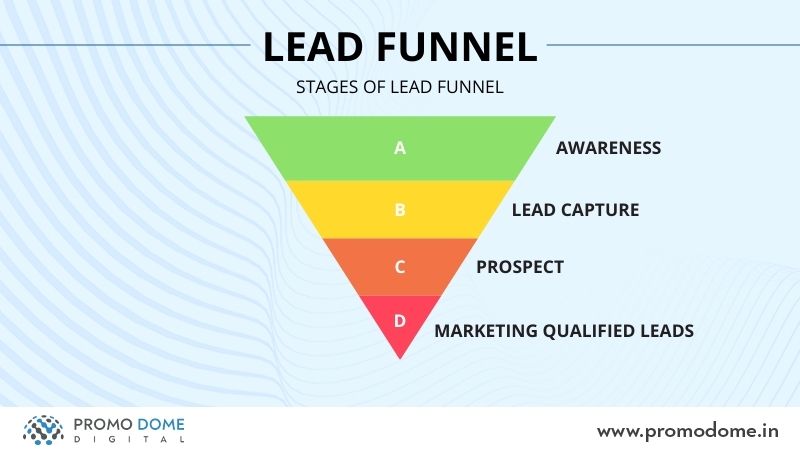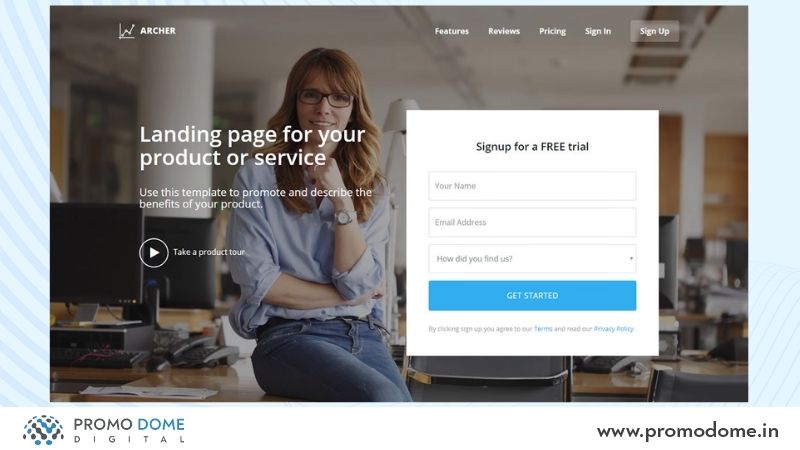A digital marketing lead funnel is the bedrock of your digital marketing strategy.
A lead is the contact information of your prospective customer who is interested in your product or service.
Finding a relevant audience who wants to use your product/service and is willing to pay for it is a challenging process. Marketers use the lead funnel to find and nurture these people online using the famous AIDAA model.
Table of Contents
What is a lead funnel?
A lead funnel is a streamlined process that marketers use to convert traffic into potential leads, which they then hand over to the sales team.
It’s a series of steps or stages that a user passes through to shift from just a visitor on your website to a high stake lead.

For example, Ramesh needs a new refrigerator. He looks for one online and stumbles on your product page. But then he moves onto some other site. Ramesh is a prospective lead. But he has a ton of options to choose from. Taking his contact information when he lands on your site will allow you the opportunity to nurture and persuade him that your product is the best solution to his problem.
The process of convincing Ramesh to share his contact information and thereon nurturing him to build a relationship with him is the objective of a lead funnel.
A lead funnel helps to push a novice user into an interested buyer. As a result, marketers spend a lot of time, energy, and resources optimizing and automating their digital marketing lead funnel, as leads are the ultimate key to sales.
So to make sales, you need to get relevant leads. Unfortunately, not all leads that enter the funnel convert into sales, so it’s essential to create a process that pulls in a consistent flow of leads.
The key to automating a consistent flow of qualified leads is setting up a quality lead funnel.
How to create a Digital Marketing Lead Funnel?
You already have a lead funnel if you are selling your products or services online; you just don’t know about it. A user has to go through several stages in your lead funnel to become a customer.
To create a lead funnel that works for your business, you need first to understand the stages of the funnel:
Stages of Lead Funnel:

Awareness
The first stage of any marketing funnel is Awareness. If your audience doesn’t know about you, how will they ever buy from you?
It would help to let your audience know about you and all that you have to offer. The best way to reach your relevant audience and educate them about your brand and its offerings is through PPC campaigns and search engine marketing.
Remember, all you are looking to do is attract the relevant audience and make them aware of your brand offerings in this stage.
As the user sees your ad, they have entered your lead funnel.
Lead Capture
This stage is about persuading the user to share their contact details willingly. Lead generation ads on social media and search engine marketing help get quality leads.
Once a user comes to your website, you need to ensure that they don’t leave without sharing their contact information as it’s the only way to contact and nurture them to move further down the funnel. Marketers spend a lot of resources to get traffic onto their website; it all goes down the drain if they fail to capture the user information.
Types of Lead generation tools:
- PPC Campaigns
- Organic Search
- Third-party integrations
You can create a form on your website to capture leads and progress the user further down the digital marketing lead funnel. It’s called a lead magnet.

Tips for the best lead magnet designs (landing page)
- Remove all distractions on the lead magnet that don’t serve the objective you are trying to achieve
- Don’t add more than a couple of links on your lead magnet page, as you want to keep them on this page and convert them into a lead.
- Ensure your communication is direct, clear, and relevant to your audience.
Depending on the stage of the AIDAA model the user is in, you can exchange content like a free e-book, free webinars, discount coupons, free trial, promotional offers, etc., for their content information.
Prospect
Now that you have a lead, it’s time to upgrade them into a prospect who will, in time, pull out his wallet for your product/ service.
You need to nurture the leads and build trust for that to happen.
Email marketing and social media marketing are the best tools for this digital marketing leads funnel stage. Promotional emails, offers, blogs, newsletters are ways you can keep them engaged and interested in your brand.
Marketing Qualified leads
This is the final role that a marketer takes in a lead funnel. They aim to convince the prospect to make a positive conversion action through all their lead capture and nurturing efforts. This could be scheduling a demo, requesting a quote, or even signing up for a free trial.
Once this is done, the digital marketing team knows that the prospect is ready to make a sales pitch, and they qualify the lead and pass them on to the sales team.
The lead funnel will vary depending on the type of product/service you sell. For some, the funnel will be shorter, and for high-stake products/services, the lead funnel will be longer and more complex. But the core stages will remain the same.
Lead Funnel Examples
The entire lead genration process is crucial, from the time a user first comes in contact with your brand and enters the funnel to the time they become qualified leads. It can start and end in several ways.
Here are a few simple lead funnel examples to help you understand the process better:
- Blog Post > Lead generation page > email list>product page
- Podcast Ad > Blog Post > Lead generation page>product page
- Facebook Ad > Landing Page > product page
- Influencer Social Post > Landing Page > email list>product page
These were linear-digital marketing funnel examples, but in reality, the journey users take to reach the checkout page is seldom linear. It’s a lot more complex than this. There are often regressions and jumps.
For example, in the marketing funnel below, even though both Customer A and Customer B came in through content marketing, they had very different customer journeys and experienced the purchase funnel differently:
Digital Marketing Funnel Strategies
Creating a customized digital marketing funnel that caters to your audience’s journey involves multiple touch points. Here are a few strategies to optimize your videos for reach and conversion.
1. Search Engine Optimization:
Often known as SEO, it is the key to enhance your online visibility by optimizing your content for search engines and users.
2. Content Marketing funnel:
This digital marketing funnel approach helps strike a connection with your audience at every step of their journey through informative and relevant content.
3. Click Funnel Marketing:
This approach involves creating a series of web pages that guide visitors to take specific actions, like product or service purchases.
4. Social Media Marketing Funnel:
Engage your audience on different social media platforms and foster relationships digitally that may lead to enhanced sales.
5. Email Marketing Funnel:
This strategy involves creating a series of personalized email campaigns that guide your audience from awareness to conversion while promoting a new product or service.
6. Paid Ads Funnel Marketing:
Leverage different types of ads to drive awareness, create interest, and increase conversions using various types of paid media.
Conclusion
A digital marketing lead funnel is the journey that a user goes through from first coming in contact with your brand to becoming a qualified lead with a high potential for conversion.
Frequently Asked Questions
Q1. How can I nurture leads and guide them to conversions?
Engage your leads with your valuable content and establish consistent communication through personalized email marketing campaigns. Monitor their behavior over time to gradually move them from leads to customers.
Q2. How do I measure and optimize the performance of my funnel?
Consistently track your KPIs, such as website traffic, conversion rate, bounce rate, ad impressions, CTRs, etc. Then, use this data to measure the performance of your digital marketing funnel against your set goals. Identify areas for improvement and consistently refine your strategies.
Q3. What is the difference between lead generation and a funnel?
Lead generation focuses on attracting your target audience, who might be interested in your service. However, a sales funnel attracts interested prospects and encourages them to buy a product or service.
Q4. How many types of funnels are there in digital marketing?
There are more than 10 types of digital marketing funnels. But what you should choose depends on your business goals and target audience.

